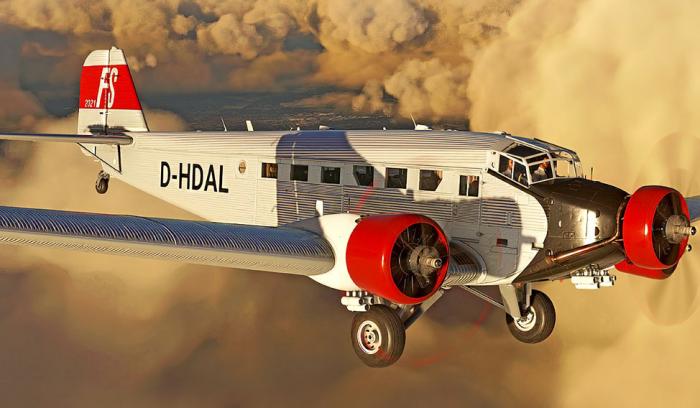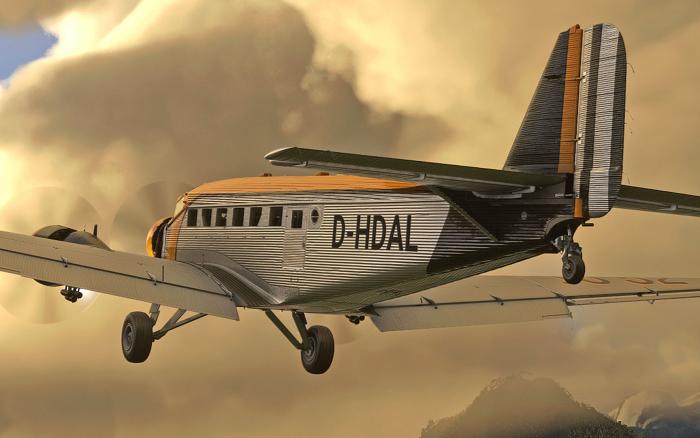Asobo models a 1930s classic
As the availability of new scenery and aircraft add-ons for Microsoft Flight Simulator (MFS) via its Marketplace continues to accelerate, we take the opportunity to review an Asobo release of a historic classic of the 1930s, the Junkers Ju 52.

As the availability of new scenery and aircraft add-ons for Microsoft Flight Simulator (MFS) via its Marketplace continues to accelerate, we take the opportunity to review an Asobo release of a historic classic of the 1930s, the Junkers Ju 52.
A classic and innovative aircraft
One of the signs of a ‘classic’ aircraft is how well it is recognised today. The Ju 52 certainly fits the bill with its distinctive corrugated duralumin skin material and the tri-motor engine configuration. Design commenced in 1930 and within two years, both the design and engine testing was complete and they were beginning to fly commercially with airlines in Europe and South America.
Capable of carrying two crew and up to 17 passengers, it hosted a range of cutting-edge features with perhaps the aforementioned duralumin outer skin being the most significant. Despite Junkers having created this skin design many years before, with it first making an appearance in 1917, it wasn’t seen commonly until the release of the Ju 52. It was a clever way of adding strength to the fuselage and wings which, when coupled with a set of duralumin spars, allowed the aircraft to have single cantilevered wings rather than the biplane construction more common at the time. It also featured an autopilot and could be easily adapted to float and ski landing gear configurations.

During World War Two, it saw extensive use as a military transport aircraft and when hostilities ceased, it continued to be manufactured, albeit in countries such as Spain, France and Ireland. There must be something about the design, as the Ju 52 continued to fly for airlines and the military in some parts of the world right into the 1980s. Sadly, there are only three now remaining in active service, although encouragingly, there are several more undergoing restoration.

The walk-around
The Asobo Ju 52 is only available via the MFS Marketplace and is based on the civilian airliner ‘3mg2e’ version with BMW Hornet engines.
The 2.27GB package includes the Ju 52 in wheeled, float and ski versions, with varying internal and cockpit layouts and textures depending on whether you select the 1939 or ‘retrofitted’ model. The latter contains more modern equipment and a cleaner, less abused panel. Additionally, some models are fitted with two-bladed props and others three. While a total of 11 different liveries are available, not all of them are available with each configuration. Keen-eyed pilots may notice that the credits mention Microsoft and Oliver Edmund Mosel. Oliver is a poet, writer, painter and well-known to X-Plane pilots as the creator of X-Plane 11 versions of the Ju 52 and the Lockheed L18 Lodestar (reviewed back in Issue 130). Now he would make an interesting dinner guest.

Downloading and installation is fully automatic with the files deposited in the official MFS Packages folder. The first thing that strikes you upon loading any of the modelled versions is how the rippling corrugated skins glisten and gleam. Almost every external surface (and many internal ones) are covered in it and they play in the light beautifully. The walk-around reveals a lot of detail when you get up-close, including the complex tailwheel design and engine exhausts that show heat tarnishing, pipe clamps etc.
Another Ju 52 feature that has been perfectly modelled is the full wing length Doppelfluegel or double-wing design. The ailerons and inboard flaps were on control surfaces that are well separated and slightly below the main wing. Also of note was the fact that each engine cowling had its own fuel and oil level indicators. There weren’t any in the actual cockpit.

The cockpit visibility is excellent with lots of glass panels, of which the side and a unique overhead window can be opened. Depending on your selection, the layout is either based on a 1939-era layout or one which has been retrofitted with more modern analogue gauges, including VOR/DME and NDB avionics. The layout will startle many as it is far from the conventional engine management layout we see today. To alarm some of you even more, the control placards are in German. To help you get started, however, you can use Ctrl+E or make it more immersive by using the built-in interactive checklists. Checking off each item will change the panel view and highlight the switch/lever you should be throwing. However, be prepared for a bit of a learning curve when you first start out.
One set of controls that is also likely to raise inquisitive eyebrows is the pair of yellow handles above the rudder pedals. They are effectively a form of rudder trim and are of great use during an extended cruise or when managing asymmetric thrust following an engine failure, which wasn’t uncommon in the 1930s.

Flight test
It is worth mentioning that on loading, the Ju 52 loads with just the pilot, co-pilot, flight engineer and only half the fuel capacity. This makes it very light indeed, which really isn’t an issue until you try to land so be sure to visit the weight and balance section when loading it to make the aircraft performance far more realistic. Once you have worked through the checklists and cranked the engines, the throaty rumbles from BMW Hornet radial engines will bring a big smile to your face. They were recorded off an actual Ju 52 in 3D giving them a satisfying roar from any position in or around the aircraft.

Ground handling is quite straightforward for a taildragger. Asymmetric thrust and a touch of brakes can assist but once rolling, it needs little managing. Having a set of throttles is a huge benefit here as you can simply map each engine to its own lever and use this to manage your taxiing whether you are flying the wheeled, ski or float version.
Directional control as you head down the runway is surprisingly stable and the trick to a smooth take-off is to allow the Ju 52’s tail to fully rise before easing back a little on the yoke and allow it to lift off. Climb performance is a steady 500fpm with very docile handling. While there is no manual whatsoever, other users have posted suggested power settings etc and actual Ju 52 manuals can be found online.
General aerial handling is also very docile and predictable (in a nice way), which is just as well as only the 1939 vintage models are fitted with a rudimentary heading and altitude hold type autopilot, which is incidentally, an accurate simulation of the innovative autopilot of the era. This stability is also very helpful when flying in IFR conditions or at night. On that point, night lighting is non-existent on the vintage models except for the default torch lighting, which to be fair, is actually perfectly adequate. The retrofitted aircraft however, do have some basic panel lighting to guide you through the night.
Approaches in the wheeled and ski versions are also easy with no nasty surprises unless you try to touch down with the airspeed on the high side, especially when at those very light default weights. It’s better to learn to adapt to the airspeed in kilometres/hour than skip off the end of the runway. The float version however is subject to the vagaries of the mediocre MFS float dynamics. I found it is near impossible to land in light weight configurations. Hopefully, MFS will receive an update in this area soon. That aside, asymmetric thrust really is needed to taxi the float version, as even the real-world Ju 52s were never fitted with water rudders.
Conclusion
While there is no doubt that a PDF manual would be extremely helpful, you cannot but help put this into some context. We have a product selling for around $15 (£11 approx) that comes in several variants/configurations, performs as you would expect for an aircraft of the era and includes the interactive checklists. While the lack of a manual and dubious floatplane dynamics are a disappointment and a few minor bugs remain, they are more than balanced by the interactive checklists system, beautiful textures and delightful handling. Add in the extremely modest price tag, and it’s hard to resist this 1930s classic for the pure fun of learning to fly and master it.
PC Pilot Verdict
At a Glance: Hard to pass it by at this price. It will provide many hours of entertaining flying despite some limitations.
Developer: Asobo, Microsoft, Oliver Mosel
Price: $15 (£11 approx)
Website: MFS Marketplace Flight
Model: Very good
Graphics: Excellent
Documentation: No manual
Systems: Very good
PC Pilot Score: 80

